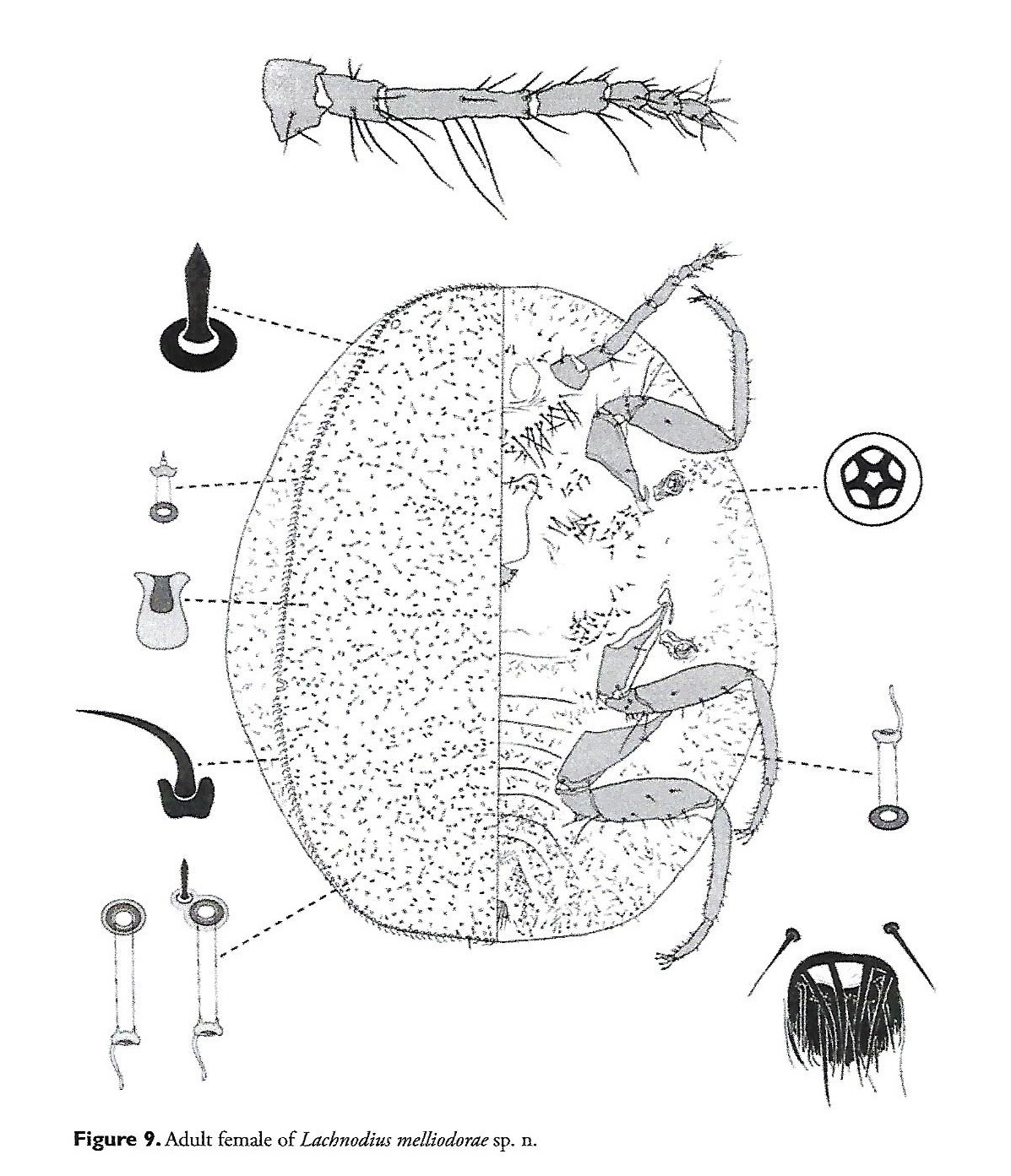Valid Names Results
Lachnodius melliodorae Beardsley, Gullan & Hardy, 2019 (Eriococcidae: Lachnodius)Nomenclatural History
- Lachnodius melliodorae Beardsley, Gullan & Hardy 2019: 74. Type data: AUSTRALIA: Lower Plenty, ex open pit fall on twig of Eucalyptus melliodora, 12/19/1971, by J.W. Beardsley.. Holotype, female, by original designation Type depository: Canberra: Australian National Insect Collection, CSIRO Entomology, Australia; accepted valid name Notes: Paratypes: Victoria: two adult females, same data as holotype (ANIC); four adult females, three second-instar females, same data as holotype, except V-241, 12 Dec 1971 (BPBM); one parasitized second-instar female, same data as holotype, except 16 Oct 1971; four adult females, one second-instar female and eight first-instar nymphs, same data as holotype except 1 Jan 1972 (first-instar nymphs reared in lab from ovisac) (BPBM except one slide of nymphs in ANIC). Illustr.
Common Names
Ecological Associates
Hosts:
Families: 1 | Genera: 1
- Myrtaceae
- Eucalyptus | HardyBeGu2019
- Eucalyptus melliodora | HardyBeGu2019
- Eucalyptus viminalis | HardyBeGu2019
Geographic Distribution
Countries: 1
- Australia
- New South Wales | HardyBeGu2019
- South Australia | HardyBeGu2019
- Victoria | HardyBeGu2019
Keys
- HardyBeGu2019: pp.50-51 ( Adult (F) ) [Species of Lachnodius]
Remarks
- Systematics: http://zoobank.org/E160E86A-DB9D-494E-A1B9-A2B019F16EC7 Adult females of L. melliodorae are most similar those of L. parathrix and L. maculosus. These three species share (i) a marginal fringe composed of close-set setae interrupted between the thorax and abdomen; (ii) two distinct size classes of quinquelocular pores on the venter; and (iii) several dorsal macrotubular ducts with a seta affixed to the dermal orifice. Adult females of L. melliodorae can be distinguished from those of . parathrix and L. maculosus by having (i) recurved marginal setae (marginal setae straight in L. parathrix and L. maculosus) and (ii) an U-shaped sclerite between the thorax and abdomen on the margin on each side of the body (sclerite absent in L. parathrix and L. maculosus). (Hardy, et al., 2019)
- Structure: Adult female body outline circular to ovate; length 1.96–5.74 mm, greatest width 1.53–3.90 mm. Eyes dorsal, 38–45 μm wide. Antennae seven-segmented. Dorsum with numerous urn-shaped sclerotic invaginations; marginal fringe of curved setae; some dorsal macrotubular ducts with seta touching rim; anal ring invaginated. Young adult females collected near Benalla, Victoria, by PJG in 1996 and 1997 were pale yellow in life with dorsomedial longitudinal stripe of red-wine color; the anterior spiracular furrow was visible as a pale line on each side of the body. The dorsum was naked (no secretion), but each seta in the marginal fringe was covered in a glassy secretion. The second-instar female had a salmon-colored dorsum. (Hardy, et al., 2019) First-instar nymph body outline ovate; length 280–360 μm, greatest width 215–290 μm. Eyes 12–15 μm wide. Antennae six-segmented but appearing 5-segmented due to partial fusion of segments III and IV. The first-instar nymphs of L. melliodorae are most similar to those of L. froggatti and L. lectularius, which also have (i) dorsal sclerotic spots (poorly developed L. froggatti); (ii) stout marginal setae subtended by patches of sclerotic cuticle; and (iii) broad audal sclerotizations (but in L. lectularius, only the caudal seta and 1 enlarged fringe seta are part of the sclerotization). The first-instar nymphs of L. eucalypti lack both the sclerotized area surrounding the socket of each marginal seta and the broad caudal sclerotizations, but have dorsal sclerotic spots. The nymphs of all four species have a similar arrangement of ducts, pores and setae. The first-instar nymphs of L. melliodorae can be distinguished from those of L. eucalypti, L. froggatti and L. lectularius by the distinctive shape of the marginal setae: deltate, with anterolateral margin sinusoidal and posteromedial margin straight, and base broad (marginal setae of L. eucalypti mostly falcate, with setal base constricted; of L. froggatti falcate but shorter than those of L. eucalypti; of L. lectularius more elongate, conical, with both margins straight). (Hardy, et al., 2019)
- General Remarks: Detailed description and illustration in Hardy, et al., 2019.
Illustrations
Citations
- GiraldWiDo2024: behavior, distribution, host, Dataset S4
- HardyBeGu2019: description, diagnosis, distribution, genebank, host, illustration, key, taxonomy, 74-77



